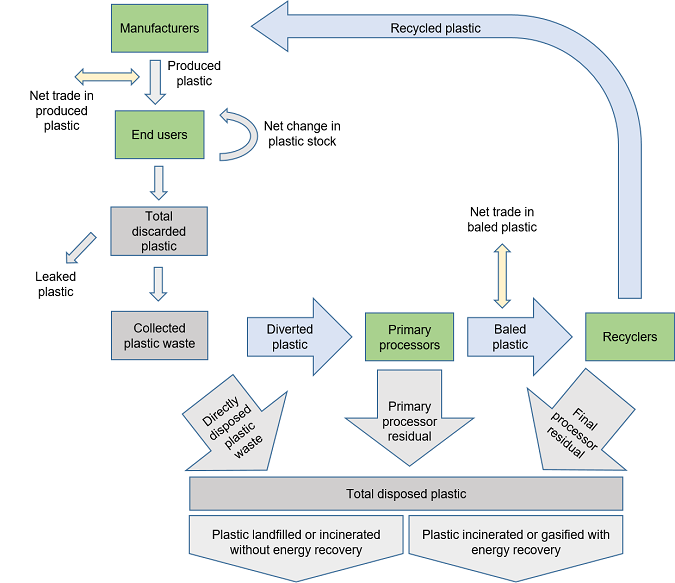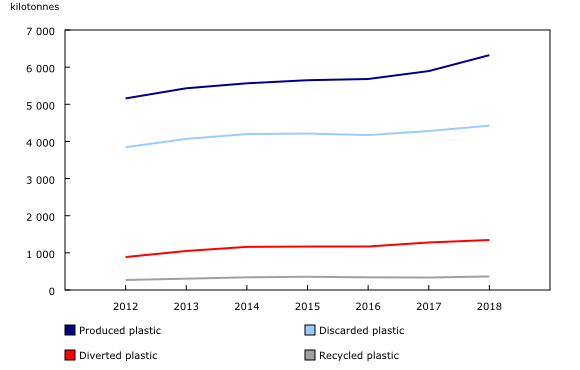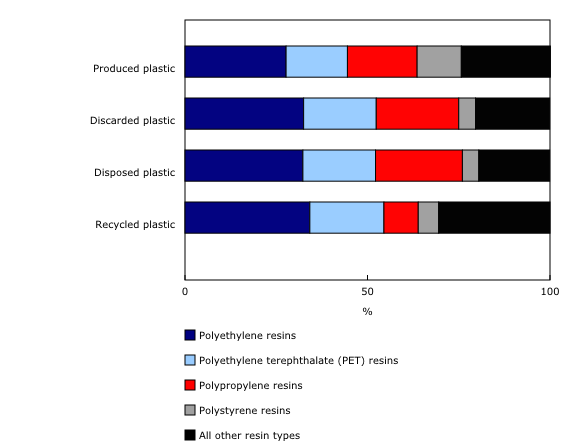Pilot physical flow account for plastic material, 2012 to 2018
Archived Content
Information identified as archived is provided for reference, research or recordkeeping purposes. It is not subject to the Government of Canada Web Standards and has not been altered or updated since it was archived. Please "contact us" to request a format other than those available.
Released: 2022-03-23
The pilot physical flow account for plastic material is a new environmental-economic account that estimates the flow of plastic through the Canadian economy. The account features breakdowns by product category, resin type, and province or territory, and it is a time series covering reference years 2012 to 2018.
The flow begins with production, continues through use, and then examines the various fates of plastic. Initially, plastic in items discarded in Canada either enters a waste management system or is leaked directly to the environment. After entering a waste management system, in order to be successfully recycled, plastic must first be diverted for material recovery, then sorted and baled, and then finally recycled into pellets or flakes ready to be made into new products. All plastic that is not successfully recycled or exported is disposed of, either in landfills or with incineration or gasification.
Canadian consumption of plastic growing faster than disposal; a large majority continues to be permanently disposed of in landfills
In 2018, the amount of plastic in items produced for Canadian consumption was 6 323 kilotonnes (kt). It represents an increase of 23% over the 2012 level of 5 158 kt, a higher rate of growth than that of real gross domestic product, which grew 15% from 2012 to 2018. In 2018, 66% of this plastic came from domestically produced items, and 34% was the plastic content of net trade. Net trade is calculated as the amount of plastic in items imported into Canada minus the amount of plastic in items exported from Canada.
Packaging—which includes items such as bottles, containers and bags—constituted 35% of all plastic in products made for Canadian consumption in 2018. The next largest category, making up 24% of all plastic, was construction materials, which include items such as pipes, sidings, frames and insulation. The remaining product categories, containing 41% of plastic produced for Canadian consumption, include vehicles, electrical and electronic equipment, textiles, and other miscellaneous products.
Plastic is produced from many different types of resins. Some of the most common resins and uses include polyethylene (PE), for packaging films and rigid packaging; polypropylene (PP), for bottle caps and other rigid packaging; polyethylene terephthalate (PET), for beverage bottles; and polystyrene (PS), for insulated food containers and building insulation. Close to three-quarters of produced plastic came from these four resins (PE—28%; PP—19%; PET—17%; PS—12%), and these proportions remained relatively stable over the seven-year period.
Total plastic in products that were disposed of in landfills or through thermal treatment increased 15% from 2012 (3 490 kt) to 2018 (4 002 kt). This is slightly more than the rate of population growth for Canada over the same time period, so represents a slight increase from 101 kg to 108 kg of plastic disposed per person each year. The higher rate of growth for produced versus disposed plastic was largely attributable to increased plastic content of products with long lifetimes, such as buildings and vehicles. These products remain in use for a long time, so an increase in their production will come many years sooner than an increase in their disposal.
The vast majority (over 99%) of the total discarded plastic in products was collected for either disposal or material recovery, while the remainder was permanently leaked to the environment as pollution. Similarly, the large majority of discarded plastic in products continued to be permanently disposed of, either via landfilling or thermal treatment, equalling 90% (4 002 kt) of total discarded plastic in products (4 426 kt) in 2018.
Portion of discarded plastic being diverted for material recovery increases, but still significantly more than amount recycled, and differs between product categories
Although less than 10% of discarded plastic was converted to recycled plastic pellets and flakes ready for use in production, a greater portion was diverted for material recovery at an earlier stage of the waste management process: 30% (1 346 kt) in 2018, up from 23% (887 kt) in 2012. From this initially diverted material, Canada produced only 365 kt of recycled plastic in 2018 and 269 kt in 2012. However, there are significant differences in trends between product categories.
From 2012 to 2018, plastics contained in discarded electrical and electronic equipment were most likely to be converted into recycled plastic. The highest portion reported was in 2015, at 21%, and the lowest was in 2018, at 14%. Discarded plastic in the packaging product category also posted an above-average rate of conversion to recycled plastic. The highest rate was 14%, in 2018, while the lowest was 10%, in 2012.
The electronics and bottles subcategories were the main drivers of these recycling trends in the electrical and electronic equipment and packaging product categories, respectively. The rate at which discarded bottles were converted to recycled plastic was consistently near or above 40%. One similarity between electronics and bottles was that they were both covered by extended producer responsibility programs in most provinces and territories.
At the other end of the spectrum, less than 1% of plastic content in discarded vehicles was successfully converted to recycled plastic, and there is little data on the amount of plastic in discarded textiles that is recycled.
Majority of recycled plastic comes from packaging; this is reflected in its distribution among resin types
In 2018, packaging products were the source of 83% (301 kt) of all recycled plastic. Accordingly, the resins most commonly used for packaging made up the largest shares of recycled plastic. Together, PE (125 kt) and PET (74 kt) made up over half (54%) of all recycled plastic in 2018. Polyvinyl chloride, PP and PS comprised nearly one-third (31%) of recycled plastic, and the remaining 15% came from various other resins.
While 2018 saw the highest output of recycled plastic in the time series, it still represented a small fraction of the total amount of plastic used to make products for Canadian consumption. The 365 kt of plastic recycled into pellets and flakes in 2018 represented 6% of the estimated 6 323 kt of plastic in items produced for Canadian consumption.
Magnitude of provincial and territorial plastic flows largely reflects population, although there are no definitive regional trends
In 2018, 10% (458 kt) of plastic in products discarded in Canada was sorted and baled. From this amount, there was a net international export of 16 kt of baled plastic, 365 kt were successfully converted to recycled pellets and flakes within Canada, and a further 76 kt became residual plastic waste and scrap sent for disposal by final processors.
Quebec (14%) furthest exceeded the national average of 10% for sorting and baling plastic from discarded products, while Nunavut (less than 1%) was the furthest below. Yukon (12%), British Columbia (12%), Nova Scotia (12%) and Saskatchewan (11%) also exceeded the national average and showed that there do not seem to be regional trends.
In 2018, the majority of recycled plastic pellets and flakes ready for use in the production of new products or chemicals was derived from products discarded in the most populous provinces. Approximately one-third were derived from products discarded in each of Ontario (34%) and Quebec (32%). Discarded products from British Columbia (15%) and Alberta (10%) also contributed significant shares of the national total.
Note to readers
The pilot physical flow account for plastic material (PFAPM) was created to support the Government of Canada's comprehensive zero plastic waste agenda. It is an experimental project estimating the life cycle of plastic in Canada. The account is investigational in nature, and it allows for the exploration of long-term trends in plastic use. If the PFAPM is produced again in the future, Statistics Canada may adjust the methodology based on the lessons learned from this project and changes to data sources.
The PFAPM accounts for the plastic content of internationally imported and exported products, as well as international imports and exports of sorted and baled plastic waste. The PFAPM does not account for international trade in recycled plastic, nor does it account for interprovincial trade in sorted and baled plastic, or recycled plastic. As a result, the geographic dimension of estimates for recycled plastic represents the province or territory where the plastic was discarded, not the location of the final processor producing the recycled pellets and flakes.
The PFAPM estimates only the weight of plastic in produced, discarded, diverted, and disposed items, not the total weight of an item itself or of other materials that make up the item. For example, it does not include the weight of metal in vehicles or the portion of that metal that is recycled.
In the account, recycled plastic includes only plastic recovered from discarded items that enter waste management streams and are processed into pellets and flakes for use in the production of new products or chemicals. Items that may be reused, such as vehicles or clothes, are accounted for in the net stock of plastic in products that remain in use at the end of each year. This variable is the difference between plastic in items produced for Canadian consumption and total discarded plastic in products, and it accounts for items that are produced in the current year but will only be discarded in future years; items that were produced in previous years and are being discarded in the current year; and products that are being discarded by one user and reused by another, without entering a waste management stream.
Contact information
For more information, or to enquire about the concepts, methods or data quality of this release, contact us (toll-free 1-800-263-1136; 514-283-8300; infostats@statcan.gc.ca) or Media Relations (statcan.mediahotline-ligneinfomedias.statcan@statcan.gc.ca).
- Date modified:






